From the Exhibition:
Frontier Shores: Collection, Entanglement, and the Manufacture of Identity in Oceania
Gabrielle Tieu is the Associate Conservator at the American Museum of Natural History.
The bonnet was collected by Scottish missionary James Hay Lawrie from the island of Aneityum in Vanuatu and was accessioned by the Division of Anthropology at the American Museum of Natural History in 1896. It was selected by Shawn C. Rowlands, curator of the exhibition Frontier Shores: Collection, Entanglement, and the Manufacture of Identity in Oceania, as an example of the integration and reinterpretation of European-style garments by local populations. The hat is a variation of a “poke bonnet,” a style that became popular in the early nineteenth century, with a small crown, wide projecting brim, and ties under the chin. This hat follows the European form and includes conventional decorative materials, such as red wool trim and cotton ribbons; however, its main structure is basketry formed from pandanus leaves, which come from a palmlike tropical tree, rather than textile. The basketry is plaited, a weaving technique that has been used for centuries by peoples of the South Pacific for fabricating mats, skirts, and other garments. In addition to the plaited basketry, the brim is lined with cotton cloth and the interior of the crown with newsprint.
When the bonnet was brought to the conservation laboratory in preparation for exhibition, it was in poor condition. It was folded completely flat and covered with black soot—barely recognizable as a hat (fig. 1).
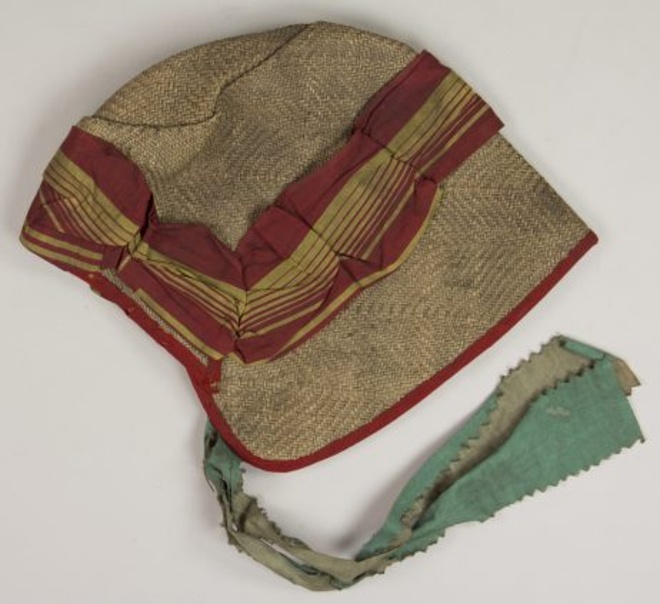
It was also very unstable, with broken seams and fibers in the plaited pandanus structure, tears in the cotton ribbon, holes in the red wool trim, and the newsprint lining was very brittle and prone to shattering (fig. 2).
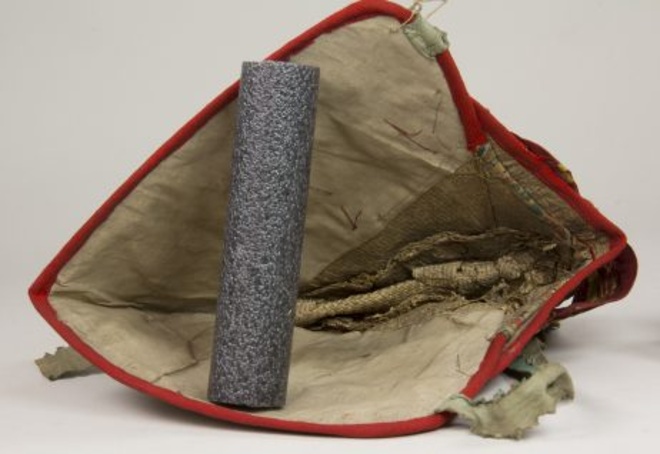
The hat could not be handled or exhibited without shedding bits of newspaper and risking further damage to the other materials. The bonnet presented a significant conservation challenge because of its composite nature, the severity of the deformations, and the extreme instability of the newsprint lining. The following outline describes the major steps of the conservation treatment.
Examination and documentation: Before any intervention, the bonnet was researched and carefully examined; its materials, manufacture, and condition were documented in a detailed report with accompanying diagrams and extensive photography.
Cleaning: Aged organic materials such as those used to make this bonnet are very fragile; thus, conservators avoid wetting them with water or other solvents that can cause further damage. This means many hours of meticulous dry cleaning, using small soft brushes, tiny pieces of foam, cotton swabs, and other tools. Initially, only the exterior of the bonnet could be cleaned; the interior was inaccessible, and some materials, such as the decorative ribbon on the crown, were too fragile for even these careful cleaning methods.
Stabilization of the decorative ribbon: The fragile red-and-yellow ribbon tended to powder and split when touched; therefore, some level of stabilization was required before further treatment. The creases in the ribbon were gently relaxed through humidification, and splits in the textile were bridged with more than fifty tiny, custom-made mesh patches or “Band-Aids” (fig. 3).
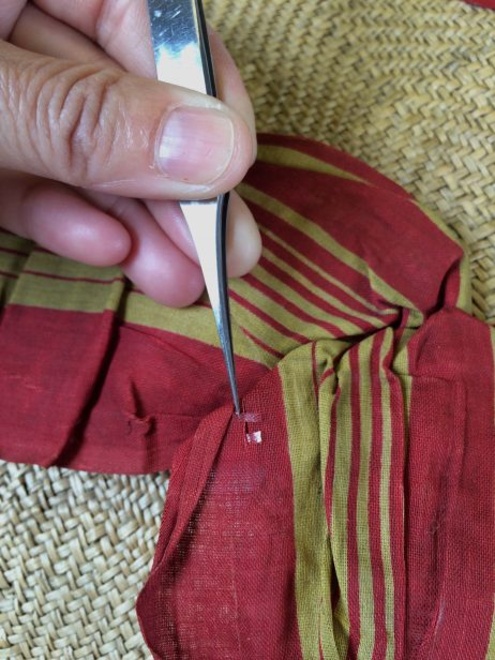
After this stabilization, the ribbon was temporarily protected with a smooth synthetic fabric, held in place with hair clips to avoid damage during subsequent treatment steps.
Reshaping: To restore the three-dimensional shape of the bonnet, each deep fold in the plaiting was humidified using a fine ultrasonic mist. Slowly and gradually, the pandanus fibers relaxed enough for the bonnet to be carefully opened and shaped with foam blocks (fig. 4).
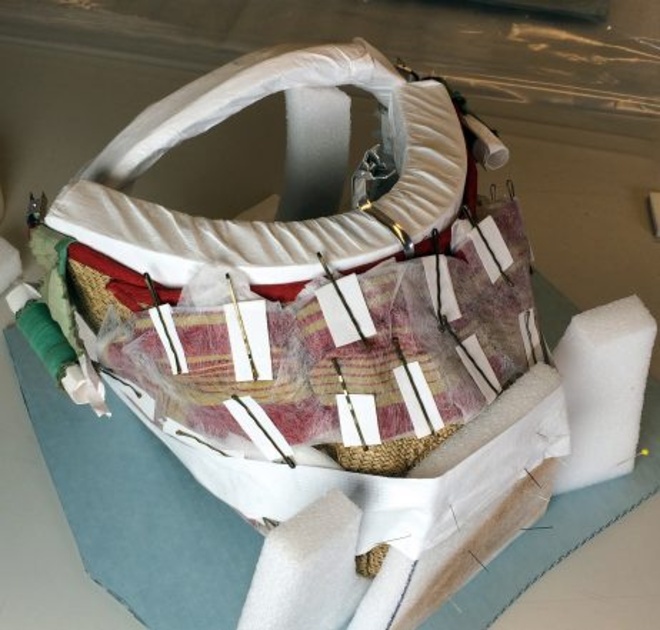
This process was quite unnerving, as the newsprint lining unavoidably crumbled and detached with the necessary manipulation of the bonnet. The locations of the detached fragments were carefully documented with digital photography to assist with their later treatment.
Stabilization of basketry: Once the hat was opened, the basketry structure was stabilized. The treatment goal was to make the repairs durable but also removable without causing damage and readily distinguishable from the original. Damaged seams were re-sewn, and losses and breaks in the pandanus plaiting were repaired. Most of the materials used for the mends were modern synthetic films and fibers, chosen for their stability and compatibility with the original materials. A custom-made head form was fabricated from archival materials to help maintain the correct shape of the bonnet after treatment. This support will be used for future storage, handling, transportation, and
display (fig. 5).
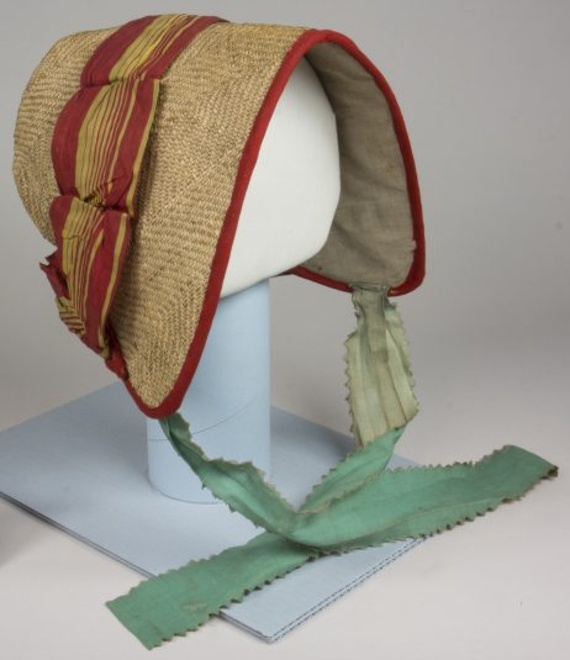
Treatment of newsprint: The newsprint lining was extremely brittle because of the inherent poor quality of the paper as well as the presence of an aged natural resin that was used to adhere it to the bonnet’s interior. Where newsprint was still present inside the bonnet, it was stabilized by re-adhering it to the plaiting. Some eighty small fragments of the paper lining, however, were detached during the reshaping of the bonnet. These tiny fragments were humidified and flattened and then lined with a fine Japanese paper. Using photographs and word cues, the slow, painstaking process of reconstruction began. About half of the fragments were successfully assembled, forming a relatively large readable section (fig. 6).
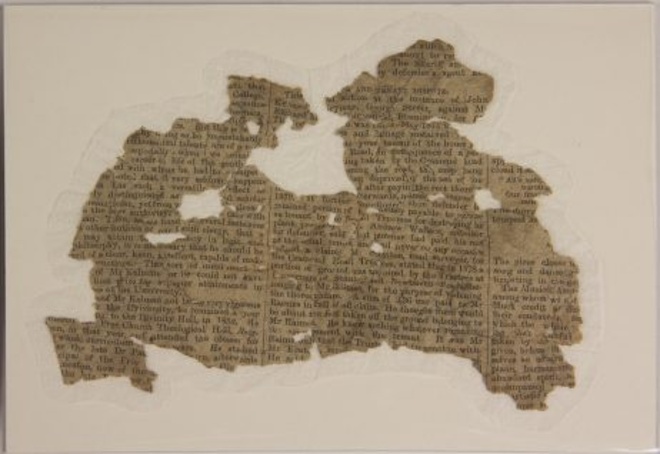
The curator was able to determine that the newsprint was Scottish and likely dated from around 1878 (the year is mentioned in the reconstructed text). After discussion with Jenny Newell, curator of Pacific Ethnology at the American Museum of Natural History, it was decided not to re-adhere this newsprint section inside the bonnet. It is displayed alongside the bonnet and will be stored separately, accessible for research without removing the supportive head from the bonnet.
This conservation treatment proved quite time consuming and challenging. Until the bonnet was opened and reshaped, the condition of the newsprint lining was uncertain, so the treatment plan had to be continually adjusted as the work progressed. The bonnet certainly benefited from such meticulous treatment. A much better understanding of its fabrication was gained, and its overall appearance was significantly improved for its display at the Bard Graduate Center Focus Gallery.
